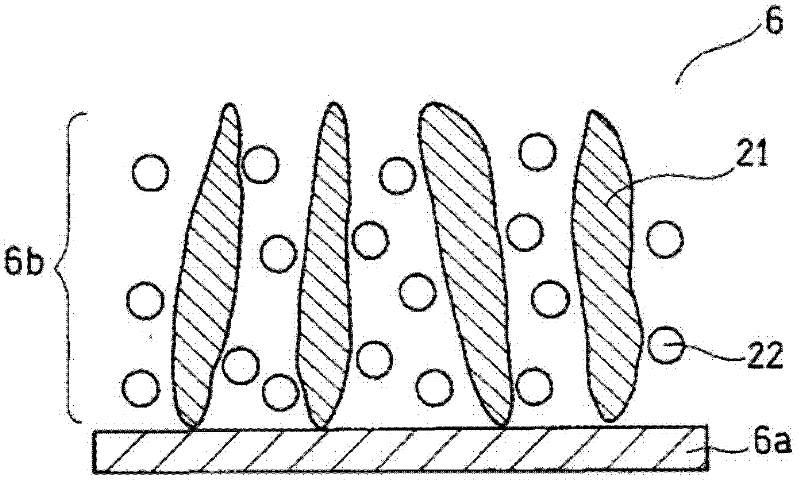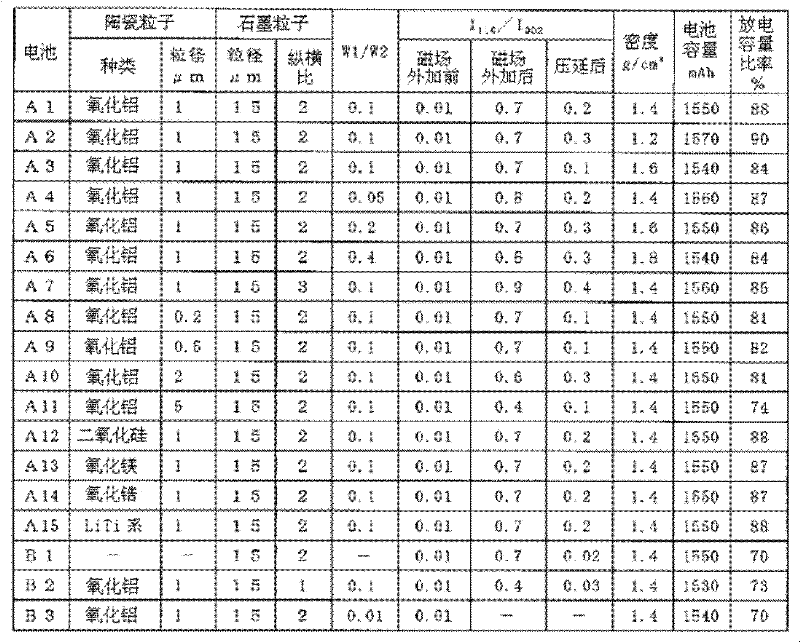Negative electrode for nonaqueous electrolyte secondary battery, method for producing same, and nonaqueous electrolyte secondary battery
A non-aqueous electrolyte and secondary battery technology, which is applied in the direction of battery electrodes, negative electrodes, active material electrodes, etc., can solve the problems of decreased discharge capacity, diffusion failure, and difficulty in deintercalation of lithium ions, so as to suppress the disorder of orientation and improve Effect of Large Current Characteristics
- Summary
- Abstract
- Description
- Claims
- Application Information
AI Technical Summary
Problems solved by technology
Method used
Image
Examples
Embodiment 1
[0110] (1) Production of positive electrode
[0111] Contains lithium nickelate (LiNiO 2 ), an appropriate amount of NMP is added to the mixture of acetylene black as a conductive material and polyvinylidene fluoride (PVDF) as a binder. The obtained mixture was kneaded with a planetary mixer to obtain a slurry-like positive electrode mixture (positive electrode slurry).
[0112] The positive electrode slurry was coated on both surfaces of a positive electrode current collector made of aluminum foil (thickness 15 μm, width 100 mm), and air-dried at 80° C. for 20 minutes. The obtained positive electrode current collector having the coating film was rolled with a roll at a linear pressure of 2000 kgf / cm (19.6 kN / cm). Thus, the positive electrode 5 in which the positive electrode mixture layers were formed on both surfaces of the positive electrode current collector was obtained. The thickness of the positive electrode mixture layer was 40 μm, and the thickness of the positive ...
Embodiment 2
[0128] A negative electrode was fabricated in the same manner as in Example 1 except that the linear pressure during rolling was 100 kgf / cm (980 N / cm). The density of the negative electrode mixture layer is 1.2g / cm 3 . Using the obtained negative electrode, a battery A2 was obtained in the same manner as in Example 1.
Embodiment 3
[0130] A negative electrode was produced in the same manner as in Example 1 except that the number of times of rolling was changed to two. The density of the negative electrode mixture layer is 1.6g / cm 3 . Using the obtained negative electrode, a battery A3 was obtained in the same manner as in Example 1.
PUM
| Property | Measurement | Unit |
|---|---|---|
| density | aaaaa | aaaaa |
| particle size | aaaaa | aaaaa |
| particle size | aaaaa | aaaaa |
Abstract
Description
Claims
Application Information
 Login to View More
Login to View More - R&D
- Intellectual Property
- Life Sciences
- Materials
- Tech Scout
- Unparalleled Data Quality
- Higher Quality Content
- 60% Fewer Hallucinations
Browse by: Latest US Patents, China's latest patents, Technical Efficacy Thesaurus, Application Domain, Technology Topic, Popular Technical Reports.
© 2025 PatSnap. All rights reserved.Legal|Privacy policy|Modern Slavery Act Transparency Statement|Sitemap|About US| Contact US: help@patsnap.com



